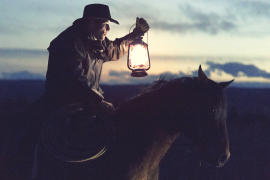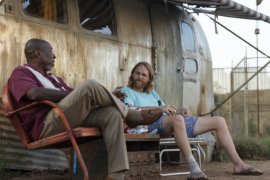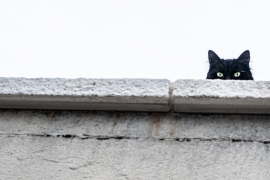I HAVE NEVER TRUSTED THE ENDING OF THE FAMOUS THE TWILIGHT ZONE EPISODE “EYE OF THE BEHOLDER”. We’re supposed to believe that this Janet Tyler, the beautiful, dangerous woman with the shining human face kept bandaged for most of the episode in a world led and populated by people with hideous pig faces—the new societal norm of beauty—is saved from death or torture by being taken away to a comfortable safe haven with others ‘of her kind’? No, I assure you that she’s hauled off to some concentration camp disguised as Eden—a ‘ghetto for freaks’ as Janet exclaims in painful ecstasy from behind the layers of gauze, a place where the necessary aftercare following her failed plastic surgeries (all as mentioned by her medical staff) I’m sure doesn’t exist. Could she really be safe in a world where such a government banishes its citizens based solely on their appearance, repressing human nature as a whole by attacking the same all-American social and materialistic values of yesterday and today we’ve all come to know and love (or hate)? I also think the ending hits different than it would have if there had been a man under those bandages. Men of the 1960s can fight for themselves against alien or Communist foe alike, own their own credit cards under their own names and maybe a gun in their pocket if all else fails, right? What do the Betty Drapers have? Purses full of husband’s hard-earned dollar bills, and if no lipstick pistol is available, their charm and/or cleavage might deter a potential enemy …
… but if women have so little of their own to give in the sexist atmosphere of Cold War-era television, then why is Nan Adams–the heroine of the tragic, renowned episode “The Hitch-Hiker”—a lonely, alone young woman, driving herself through a nightmarish road trip, interacting flirtatiously or solemnly with the men she meets along the way to her unknown destination not because she is a meek woman, frightful of all masculinity yet humbly respectful of the same, but because she is a soft, sad, smart girl, once captivating to others but now awkward with even herself, monologuing internally across highways, almost aware of our voyeuristic presence and annoyed with our indifference and the help we cannot give, but still too scared to ask for help? Her death, the famous final plot twist (doo doo doo doo indeed), comes as a shock to all of us, the loss of youth something to pity regardless of gender or context. After 24 minutes with her, I doubt anyone hasn’t become smitten with this splendid philosopher woman, the only female across highways full of anonymous men, just as I doubt anyone would wish to dog her with questions like, “Why did you think driving yourself across the country alone would be a good idea?” Instead, we just feel numb. We sympathize with or even relate to her, frighteningly enough for us young women perhaps seeing ourselves in her character, or for our fathers, crying over the loss of precious innocence and beauty, ala or instead of their own or their kids’. All is united in their mourning when Nan finally leaves us. How bittersweet.
No one I know has ever been able to predict the twist in “The After Hours”, including myself. A young, single, and bright Marsha White enters a mysterious department store and is subsequently terrorized by an elegant older woman, one who assumes a surreal maternal quality toward the end of their half-hour together, and is revealed in fact to be a mannequin, given one month of human freedom, same as all her plastic peers. What seems a tragic fate for our lovely heroine is not quite so; having outstayed her allotted time as human, we should naturally feel worse for the others, not allowed their own fun while waiting for her inevitable return. But we don’t, instead still feeling an inadequate adoration for this girl who is not a girl, but an inanimate lifesize doll. We feel this way because we’ve been cheated. We love this girl, this poor, innocent mannequin of a girl breathlessly on her own in the city, just trying to buy a gift for her mother–who, in light of the final revelation, we wonder is real or not—yet who ends up being dragged back into the modeling life (or lack of). It almost reads like an allegory for the role of woman as active, independent individual vs passive, decorative object, although maybe deep down we know it’s simpler than that. As a science fiction story, a pretty mannequin came to life, and wasn’t terrifying for once; instead, she got to live a beautiful human existence, if only for a tragically(?) short while, and then returned to her rightful place, thus allowing the same fun for the next mannequin–male or female–in line. But in its achingly realistic relation to the feminine coming of age, where a girl becomes a woman as she breaks away from her mother or guardian to understand the world for herself, it makes the ending that much harder to watch, as it signals a return to a compassionate or restrictive beginning, a world only as big as its masters wish it, surrounded only by those like you, who say they want what’s best for you but often don’t seem to act like it. Her modern independence is crushed, and she melts back into an attractive, unburdened pose, at least until she is presumably allowed outside again one day, though I’m sure with stricter rules and boundaries next time. Hasn’t every woman ‘been there’ at some point in her life?
There are so many more women of The Twilight Zone whose stories I could relate here, but frankly, experiencing them for yourselves will, I promise you, be a better and stranger thing than reading my accounts of them. You’ll meet the mute, anonymous old lady in “The Invaders”, fighting valiantly alone for her survival against tiny, weird creatures; the disillusioned, distorted ex-Hollywood starlet Barbara Jean Trenton in “The Sixteen-Millimeter Shrine”, reliving her glory days at the risk of her own sanity; two kinds of jilted lovers in “Jess-Belle” and “Come Wander with Me”, one who seeks revenge and one who merely suffers in heartbreak; the titular sentient, lovingly manipulative computer in “From Agnes – with Love”; two brave and unparalleled dystopian compatriots Norma and Mrs. Bronson in “The Midnight Sun”; and many, many more. They all deserve analysis here, but the show itself might be ruined if you were to learn everyone’s fate ahead of time, wouldn’t it? I’m merely one of many messengers of Rod Serling’s life lessons, and where better to learn than at the source of wisdom itself? Furthermore, you might find in your own viewing of these and other episodes a completely different interpretation of the women of The Twilight Zone and their stories, one totally personal and righteous to your own experience. Maybe in your eyes, Janet is safe and sound in paradise away from her ugly overlords, just as Nan is better off peaceful in death than dealing with the agonies of being a woman in the 1960s, and Marsha can more easily relax in the department store than the streets of New York. It all very well could be. Unfortunately, we’ll probably never know what really happened to any of them; but hey, that’s life.
In conclusion, there is something beautifully authentic about the rich, nuanced, and complex female characters of Rod Serling’s predominantly male-led show The Twilight Zone (1959-64). Some have physical or intellectual strength with which to fight their monsters, and some get by on wit or luck–but almost all find their own paths in life, at least for a little while, and for that we must applaud them. For those arguing the sexism of the time making this abundance of profound postwar women impossible, try an episode or two I mention, and look at life around you for what it is now, what it’s been before, and what it will be in the future: there will always be mothers who worry for their children, while they’re still children or already grown; wives who will always be concerned for the well-being of their husbands (and marriages); daughters who will always mourn or aid their corrupt or lackluster fathers; and all different, all strong, kinds of women, who will all eventually (maybe) end up in The Twilight Zone.
Finally, you might also argue that sexism and society are what prevented the showrunners from including more female-centric episodes than they did, but consider also that perhaps women are less often the protagonists of The Twilight Zone because they’re smarter, cleverer, more intelligent, than the male heroes. Maybe they just avoid constant hell easier. But a resonating fact throughout the series remains that women often escape the same kinds of fates as their male counterparts in the 5th dimension (rarely dying!) because they’re not afraid of it in the first place, having gone through probably worse in their daily lives at some point before leaving them for the new experiences within the Twilight Zone. As a matter of fact, many episodes starring women can serve as allegories for the realities of mid-20th century womanhood: marrying the wrong guy (“Spur of the Moment”, “Young Man’s Fancy”), unhealthy body standards (“Number 12 Looks Just Like You”), parental power struggles from childhood to adulthood (“Living Doll”, “The Lateness of the Hour”), identity crises (“Mirror Image”); and many of their major dilemmas are still painfully relevant to us today.
Sure, there are more episodes starring and about purely male concerns, but for the most part, TZ’s stories and morals are universal: anybody might break their glasses when the apocalypse comes, just like anybody might want to seek revenge on a nasty stepfather with a demonic doll, and everybody has the chance to save themselves and others at some point or another. We’re all children once, and many of us get to live the experience again through our own; if we’ve been married, we can understand the highs and lows of life together, and if divorced, the same apart; old age comes for us all one day, sometimes leaving us cold and lonely, but sometimes giving us a light in the darkness. All of these aspects of the human condition are explored in starkly modern terms across eternally and thoroughly relevant episodes of The Twilight Zone, but it’s the Woman narratives which I think should attract more of a contemporary female audience than they do. If anything, watch the show for Janet, wherever she may be now; for Nan, to preserve her sad story as eulogy or dirge; for Marsha, to remember her brilliant time as human and say hi to her mannequin; and most importantly, for yourself, to stay ever vigilant of your own potential entrance into The Twilight Zone.
(Happy 60th anniversary, TZ!)
CLAIRE MARIE ANDERSON is an Art History student, writer, actress, director, and artist from Houston, TX. Some of her nonfiction has been featured in KAIROS Literary Magazine, The Showbear Family Circus, and Internet Void, and her fiction is forthcoming in Vagabonds: Anthology of the Mad Ones. She’s doing great, thanks for asking.
Like what you’re reading?
Get new stories or poetry sent to your inbox. Drop your email below to start >>>
OR grab a print issue
Stories, poems and essays in a beautifully designed magazine you can hold in your hands.
GO TO ISSUESNEW book release
Ghost Engine by Christian TeBordo. Publisher’s Weekly says, “This serrated collection excels at knocking readers off-balance.” Order Ghost Engine by Christian TeBordo now.
GET THE BOOK



